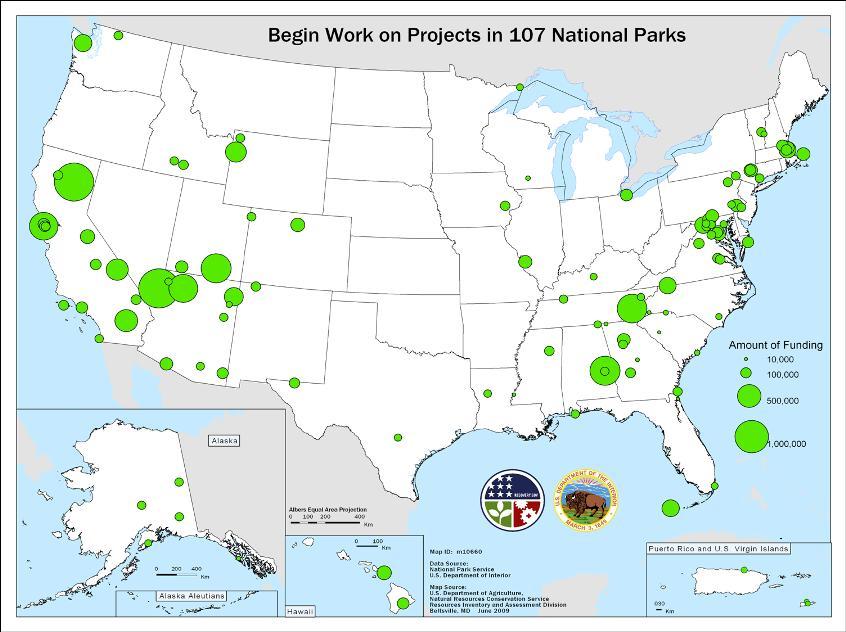In the Next 100 Days: Begin Work on Projects in 107 National Parks
Why? Recovery Act efforts will begin in parks across America, from Lake Mead and Yellowstone, to Yosemite and the Grand Canyon. The National Park Service projects will preserve and protect national icons and historic landscapes, improve energy efficiency and renewable energy use, and remediate abandoned mines. These projects will fall under six basic types of activities: construction, deferred maintenance, energy efficient equipment replacement, trails, abandoned mines, and road maintenance. Examples of each are as follows:
- Construction projects will build, rehabilitate, or replace facilities to help preserve natural and cultural resources and ensure safe, fun, and educational experiences for visitors.
- Deferred Maintenance projects will repair, rehabilitate, or maintain critical facilities to extend their useful life. The NPS will undertake major repair and rehabilitation work and will complete maintenance to improve facility conditions.
- Energy efficient equipment replacement efforts will replace aging vehicles, heavy equipment, and HVAC systems with next generation energy efficient equipment. By reducing its fossil fuel consumption, the NPS will reduce its carbon footprint and fuel costs.18
- Trails projects will complete work to restore trails for safer use and to extend the life of trails across the national park system.
- The abandoned mine lands safety projects will remedy serious health and safety concerns at the sites. A consideration in choosing a particular remedy is the ability to provide continued use of the mine openings as wildlife habitat by maintaining access and airflow.
- Road maintenance projects will preserve park roads and parkways and rehabilitate deteriorated road networks. The NPS is responsible for approximately 5,450 paved miles of public park roads, 6,544 miles of unpaved roads, the equivalent of 948 paved miles of parking areas, and 1,679 structures such as bridges, culverts, and tunnels.
Parks at which Recovery Act efforts will be underway
| Abraham Lincoln Birthplace | Grand Portage | North Cascades |
| Andersonville | Grand Teton | Ocmulgee |
| Andrew Johnson | Great Smoky Mountains | Olympic |
| Antietam | Guadalupe Mountains | Organ Pipe Cactus |
| Assateague Island | Gulf Islands | Perry’s Victory and International Peace Memorial |
| Aztec Ruins | Hagerman Fossil Beds | Petrified Forest |
| Biscayne | Haleakalā | Richmond |
| Blue Ridge Parkway | Harpers Ferry | Rock Creek Park |
| Boston | Hawai’i Volcanoes | Rocky Mountain |
| Cabrillo | Herbert Hoover | Russell Cave |
| Cane River Creole NHP and Heritage Area | Home of Franklin D. Roosevelt | Saguaro |
| Canyon de Chelly | Hopewell Furnace | Saint-Gaudens |
| Cape Cod | Hubbell Trading Post | Salt River Bay NHP & Ecological Preserve, St. Croix |
| Carl Sandburg Home | Ice Age Trail | San Antonio Missions |
| Catoctin Mountain Park | Independence | San Francisco Maritime |
| Channel Islands | Jefferson National Expansion Memorial | San Juan |
| Chattahoochee River | Joshua Tree | Santa Monica Mountains |
| Chesapeake and Ohio Canal | Kenai Fjords | Saugus Iron Works |
| Chickamauga and Chattanooga | Kings Mountain | Sequoia and Kings Canyon |
| Chiricahua | Lake Mead | Shenandoah |
| Christiansted | Lassen Volcanic | Sitka |
| Cumberland Island | Longfellow | Steamtown |
| Death Valley | Lowell | Timucuan Ecological and Historic |
| Denali | Maggie L. Walker | Tuskegee Airmen |
| Dinosaur | Manassas | Tuskegee Institute |
| Dry Tortugas | Marsh-Billings-Rockefeller | Upper Delaware Scenic and Recreation River |
| Fort Donelson | Martin Luther King, Jr. | Valley Forge |
| Fort McHenry NM and Historic Shrine | Minidoka Internment, S. Central | Vanderbilt Mansion |
| Fort Point | Mojave | Weir Farm |
| Fort Sumter | Monocacy | Whiskeytown Unit |
| George Washington Memorial Parkway | Moores Creek | Wrangell-St. Elias |
| Gettysburg | Muir Woods | Yellowstone |
| Glen Canyon | Natchez | Yosemite |
| Golden Gate | Natchez Trace Parkway | Yukon-Charley Rivers |
| Grand Canyon | National Capital Parks - East | Zion |
| Grand Canyon Parashant | Ninety Six |








